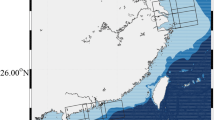Abstract
Some missions have been carried out to measure wave directional spectrum by synthetic aperture radar (SAR) and airborne real aperture radar (RAR) at a low incidence. Both them have their own advantages and limitations. Scientists hope that SAR and satellite-based RAR can complement each other for the research on wave properties in the future. For this study, the authors aim to simulate the satellite-based RAR system to validate performance for measuring the directional wave spectrum. The principal measurements are introduced and the simulation methods based on the one developed by Hauser are adopted and slightly modified. To enhance the authenticity of input spectrum and the wave spectrum measuring consistency for SAR and satellite-based RAR, the wave height spectrum inversed from Envisat ASAR data by cross spectrum technology is used as the input spectrum of the simulation system. In the process of simulation, the sea surface, backscattering signal, modulation spectrum and the estimated wave height spectrum are simulated in each look direction. Directional wave spectrum are measured based on the simulated observations from 0° to 360°. From the estimated wave spectrum, it has an 180° ambiguity like SAR, but it has no special high wave number cut off in all the direction. Finally, the estimated spectrum is compared with the input one in terms of the dominant wave wavelength, direction and SWH and the results are promising. The simulation shows that satellite-based RAR should be capable of measuring the directional wave properties. Moreover, it indicates satellite-based RAR basically can measure waves that SAR can measure.
Similar content being viewed by others
References
Alpers W R, Hasselmann K. 1978. The two-frequency microwave technique for measuring ocean wave spectra from an airplane or satellite. Boundary Layer Meteorol., 13: 215–230
Alpers W R, Ross R D, Rufenach C L. 1981. On the detecablility of ocean surface waves by real and synthetic aperture radar. J Geophys Res, 86: 6481–6498
Engen G, Johnsen, H. 1995. SAR-ocean wave inversion using image cross spectra. IEEE transactions on geoscience and remote sensing, 33: 1047–1056
Hasselmann K et al. 1985. Theory of synthetic aperture radar ocean imaging: A MARSEN view. J Geophys Res, 90: 4659–4686
Hasselmann K, Hasselmann S. 1991. On the nonlinear mapping of an ocean wave spectrum into a synthetic aperture radar image spectrum and its inversion. J Geophys Res, 96: 10713–10729
Hauser D, Caudal G, Rijchenberg G. Vidal-madjar, D, Laurent G, Lancelin P, RESSAC: A new airborne FM/CW radar ocean wave spectrometer IEEE, 30: 981–995
Hauser D, Soussi E, Thouvenot E., et al. 2001. SWIMSAT: A real-aperture radar to measure directional spectra of ocean waves from space-main characteristics and performance simulation AMS, 18: 421–437
Jackson F C. 1981. An analysis of short pulse and dual frequency radar techniques for measuring ocean wave spectra from satellites Radio Sci, 16: 1385–1400
Jackson F C, Walton W T, Peng C Y. 1985. A comparison of in situ and airborne radar observations of ocean wave directionality J Geophys Res, 90: 1005–1018
Jackson F C, Walton W T. 1985. Aircraft and satellite measurement of ocean wave directional spectra using scanning-beam microwave radars. J Geophys Res, 90: 987–1004
Jackson F C. 1987. The physical basis for estimating wave-energy spectra with the radar ocean-wave spectrometer Johns Hopkins APL Technical Digest, 8: 70–73
Jackson F C. 1987. The radar ocean-wave spectrometer Johns Hopkins APL Technical Digest, 8: 116–127
Mastenbroek C, Valk C F. 2000. A semiparametric algorithm to retrieve ocean wave spectra from synthetic aperture radar. J Geophys Res, 105: 3497–3516
Mouche A A, Hauser D, Daloze J F, et al. 2005. Dual-polarization measurements at C-band over the ocean: results from airborne radar observations and comparison with ENVISAT ASAR data. IEEE, 43: 753–769
Tison C D, Hauser, Carayon G, et al. 2008. A spaceborne radar for directional wave spectra estimation-first performance simulations. IGARSS. I: 347–350
Valenzuela G R. 1978. Theories for the interation of electromagnetic and oceanic waves-a review Bound.-Layer Meteor, 13: 61–85
Author information
Authors and Affiliations
Corresponding author
Additional information
Foundation item: The National Natural Science Foundation of China under contract No. 40730843 and the National High Technology Development Program (“863”Program), under contract No. 2007AA12Z182.
Rights and permissions
About this article
Cite this article
Ren, L., Mao, Z., Huang, H. et al. Satellite-based RAR performance simulation for measuring directional ocean wave spectrum based on SAR inversion spectrum. Acta Oceanol. Sin. 29, 13–20 (2010). https://doi.org/10.1007/s13131-010-0046-7
Received:
Accepted:
Published:
Issue Date:
DOI: https://doi.org/10.1007/s13131-010-0046-7



